How to connect a switch with one key: rules and connection diagrams
To control household electric lighting sources, various devices are used, the most common of all is the switch.This is a simple device located on the wall and connected to wires. The design of the products is different, but the internal circuit diagram of the single models is the same.
In our material we will tell you how to connect a switch with one key in order to quickly make repairs. For convenience, several connection methods will be given with thematic photographs clearly demonstrating the installation process.
The content of the article:
Design and purpose of switches
A switch is a simple mechanical (less often electronic) device for contact closing/opening an electrical circuit to turn on/off lighting fixtures.
We will touch on the design features and installation of the simplest models - single-key switches.
They consist of 4 main parts:
- worker node — metal base with contacts and push-button drive;
- fasteners - legs or antennae made of metal connected to a metal plate;
- decorative design - panels or frames;
- dynamic part - plastic key.
Some parts, mainly internal ones, are made of metal, such as galvanized steel; external decorative trim is usually made of safe plastic. Ceramic elements are also available that can withstand loads of up to 32 A, while plastic is rated for 16 A.
Reasons for installing a single key switch include:
The external and internal structure depends on several factors, for example, functional tasks or potential load. As an additional device, some models have an LED that provides external illumination.
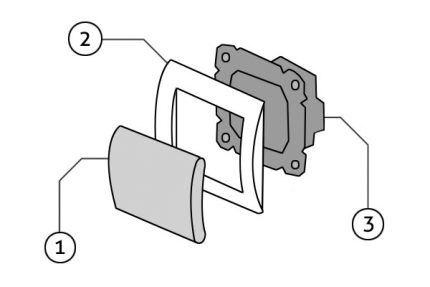
Switches are installed in all rooms where there are any lighting devices that are not equipped with a power cable (for example, it is not needed for floor lamps or table lamps).
These are most often ceiling or wall lamps, chandeliers, and complex lighting systems.

Types of devices for household use
There is no strict division into categories, since different manufacturers have their own “branded” model ranges, but we can distinguish several types of switches, united by one characteristic.
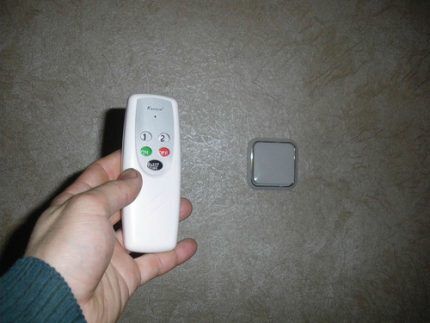
For example, according to the principle of inclusion, all devices can be divided into:
- mechanical – elementary keyboard devices, easy to install and use (the function of a key can be performed by a lever, toggle switch, button, cord, rotary knob);
- electronic touch, activated by the touch of a hand;
- with remote controlequipped with a remote control or motion sensor.
The first group is considered the most popular, traditional and recognized from the first days of the invention of the electrical circuit; the popularity of the third is also gaining momentum, but the second somehow has not caught on.
Motion sensors save energy and serve as additional protection. For example, if you install such a device at the entrance to the house, it will signal the arrival of uninvited guests.
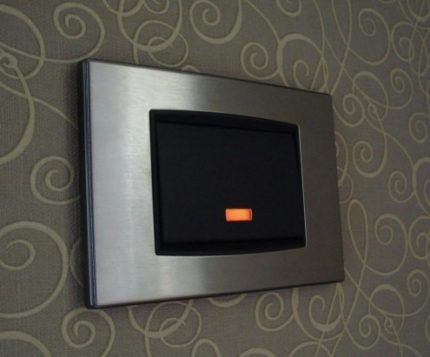
According to the type of design, all switches are divided into single-key and multi-key (standard design for household use - with 2-3 keys). Each key serves to close/open one lighting circuit.
If there are several lighting fixtures in the room - a chandelier, ceiling lighting and sconces - it is appropriate three-gang switch, which will allow you to turn on/off devices one by one or together.
Also quite popular are two-gang switches which can be seen in almost every apartment. They are especially relevant for chandeliers with several lamps.
Based on the installation method, two groups can be distinguished: with external and internal installation. Outdoor type usually used when the wiring is open, and interior – with cables sewn into the wall. To ensure the safety and stability of the installation of the built-in switch, use a mounting box (socket box) - a protective plastic case.
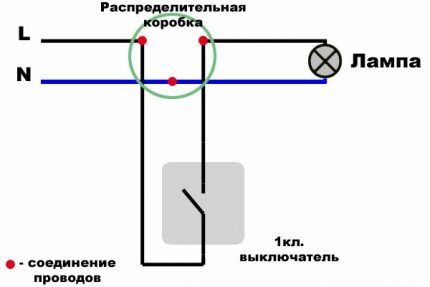
Placement - convenience and safety
Before installing a switch you should consider the most convenient location for installation and subsequent use. The most advantageous area is located near the entrance doors (from the side of the door handle), but there may be exceptions (for example, next to the head of the bed).
Before drawing up a wiring project, it is better to look at the official document - PUE (electrical installation rules), which regulates some of the nuances of installation. For example, clause 7.1.48 states that the switch must be located at least 60 cm from the shower stall, and clause 7.1.50 allows it to be installed no closer than 50 cm from the gas pipeline.
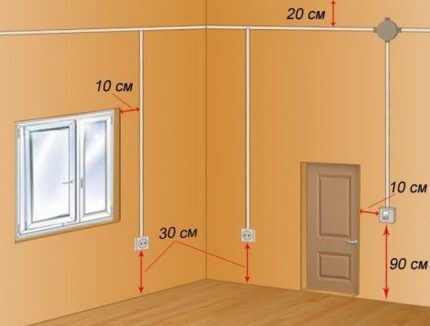
The installation of control devices in bathrooms and saunas is prohibited; they must be taken outside the room (usually into the corridor).
Three mounting options for single-key switches
Let's look at three switch connection diagrams that are similar in design (have one button), but differ in the type of installation. Also, all options are united by the basic law of introducing single-key models: the dynamic element opens the “phase” and not the “zero”. Otherwise, there may be a risk of injury during repair work and even when simply replacing lamps.
#1: Photo instructions for installing an outdoor device
The location of the wires for this connection diagram is not of fundamental importance: they can run along the surface or be inside the wall. An external type of switch in a residential area is welcome if expensive repairs have just been made and there is no desire to tear down the walls and install ducts again.
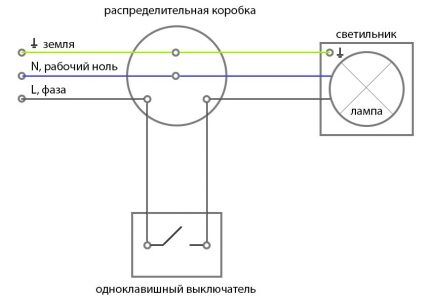
We will consider the option of external cable laying, in which the wires are enclosed in a corrugated protective channel.
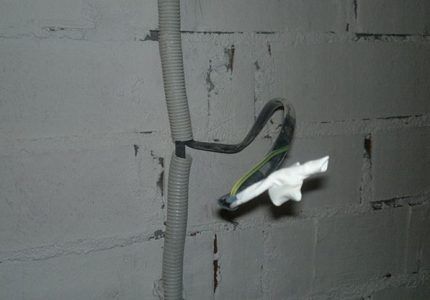
Under the switch there will be another electrical device - a socket, so the cables for both devices are enclosed in one corrugation for aesthetic reasons.
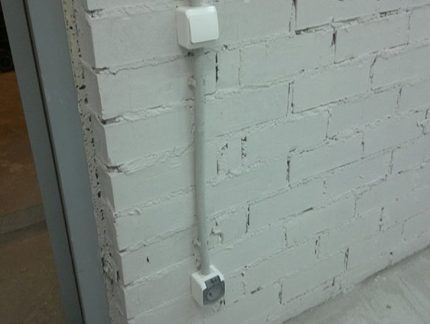
Selected breaker model - Schneider Electric – has a plastic case and IP44 protection degree. Before installation, we take safety measures: turn off the power to the cable at the electrical panel installed on the site or in the corridor.
To make sure there is no voltage in the cable, use an indicator screwdriver. When the issue of turning off the power is resolved, we begin disassembling the switch.
First, we take out the key with our hand - this is done quite easily.

The next step is to remove the working mechanism.

Now you need to accurately determine the location of installation of the switch and mark on the wall the points for screwing in the fasteners. To do this, take an already empty case and attach it to the wall.
We level it and use a marker to mark the points for drilling. Using a drill, we drill holes for fastening (another fastening method is also possible).
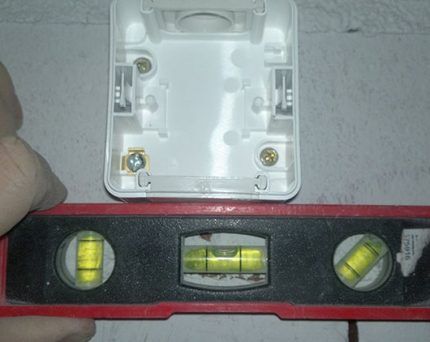
We remove the elastic plug located in the upper part from the switch body, insert the wires into the hole and the end of the corrugated pipe coming from the ceiling.

Time to start connecting directly. We remove the insulating material from the ends of the wires and strip 8-10 mm.
We connect the white wire (phase) to the terminal marked L, the blue wire to the other terminal marked “1”. Carefully tighten the bolts and place the working unit into the housing.
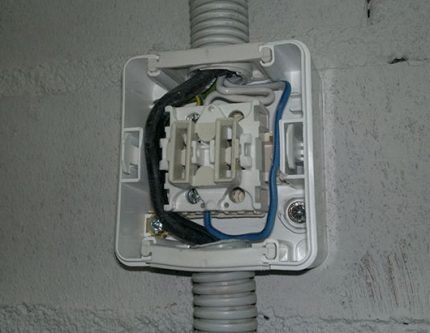
We reassemble the switch: put the front panel in place, then fix the key.
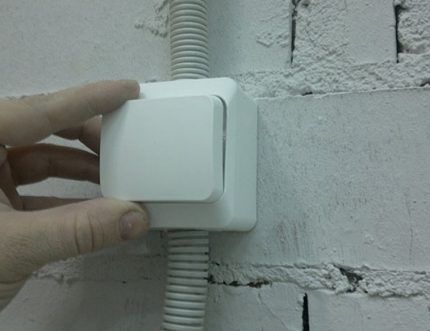
It is quite easy to install the switch yourself, even if the installation is complicated by the presence of additional devices.
However, if you are not sure of the correctness of actions, it is better to play it safe and make the first connection under the supervision of an experienced electrician.
#2: Master class on replacing an old switch
Often, in connection with renovations in an apartment or private house, it is necessary to dismantle the old switch and install a new, more modern and convenient one in its place.
Let's look at the main stages of replacing a switchusing step-by-step photographs of the process.

Using a screwdriver, unscrew the screws and remove the plastic cover.
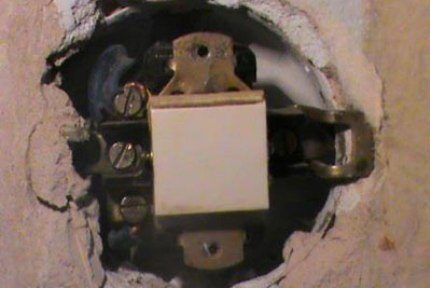
Our task is to determine the “phase”.
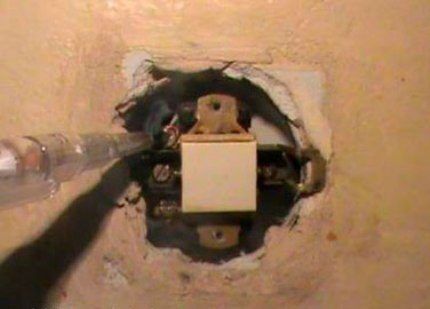
We bring the screwdriver to the contacts one by one, never touching them with our hands (it is better to use insulating gloves). For an accurate determination, set the key in both positions.
When the “phase” position is off, only one contact will be energized. The second wire is for the lighting fixture.
Having established the purpose of the wires, we turn off the electricity supply, check the presence or absence of voltage and, having made sure that it is safe, we begin to disassemble the old switch. We unscrew the fasteners of the metal holders (“claws”) and take out the working unit.
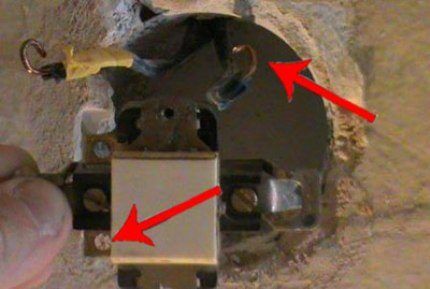
We finally release the mechanism, straighten the wires - the place for the new switch is prepared. We take a new product, purchased in advance, and prepare it for installation, in other words, we disassemble it.
We remove the key, unscrew the protective panel and see the internal mechanism - with two mandatory clamps and spacer holders.
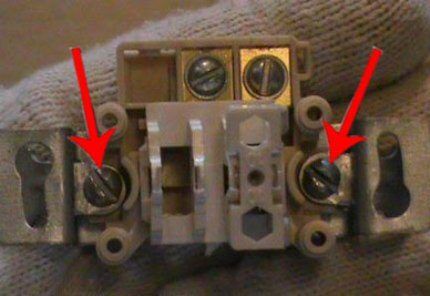
We strip the ends of the wires about 1 cm, insert them into the holes located under the upper screws, making sure that the winding does not slip inside along with the bare wire. We tighten it tightly so that the wires do not move.
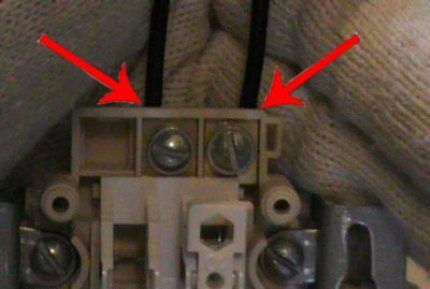
Having connected the wires, we insert the working unit into the installation box.
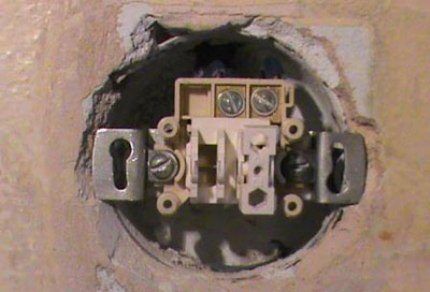
Install the top panel and fix the key.
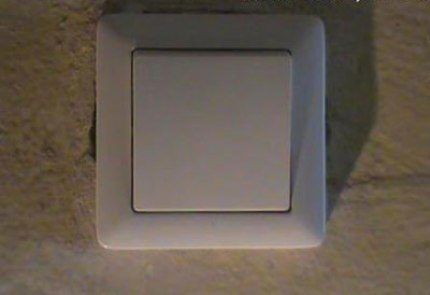
So, to install the new switch we needed tools (screwdriver, pliers, knife, wire cutters, indicator screwdriver), some insulating material and 20 minutes of time. Calling an electrician would cost about 500 rubles.
#3: Connection diagram with junction box
When you get bare walls, which is common in new modern standard houses, you have to install interior doors, lay floors, and tidy up the walls yourself.
Electrical wiring is no exception. Therefore, let's look at how to properly connect a switch along with a lighting fixture, a circuit breaker and a junction box.

Our goal is to install all the devices in their designated places and connect them to each other with wires without confusing them. We try to install the distribution box in the center.
The open or closed method of cable installation does not fundamentally affect the arrangement of circuit elements.

First of all, we connect an automatic protection device that protects the network from overloads and power surges.
Let's decide on wire color which we need to connect the switch:
- white – phase;
- blue – zero;
- yellow - Earth.
We strip the wires and insert them into the terminals intended for them. We use the yellow wire for grounding, fixing it separately with a special clamp.
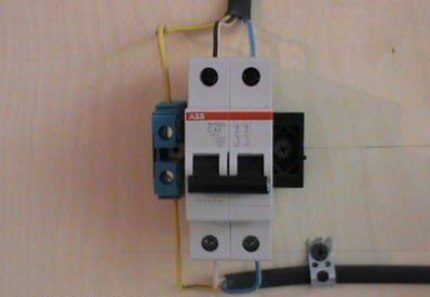
The role of the lamp will be played by an ordinary socket and a light bulb (incandescent, LED, energy-saving).

We bring the wires into the installation box to install the switch.
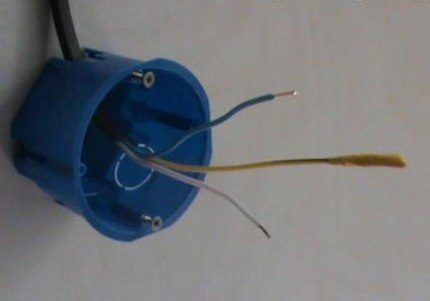
Modern models of switches have marked terminals, which makes it easier to fix the wiring. We insert them into the required holes and secure them with screws.
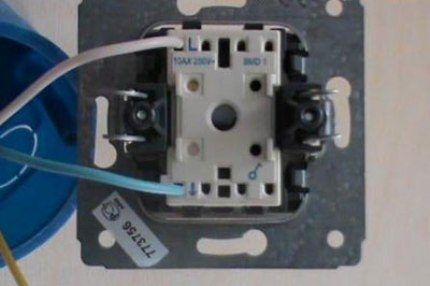
All elements of the circuit are connected, all that remains is to connect the wires in the junction box.
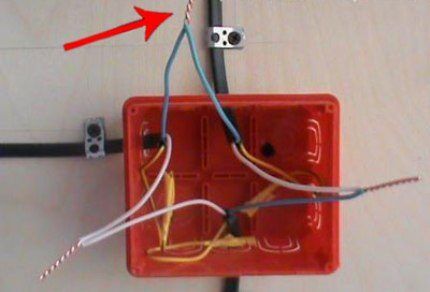
We check the correctness of the connections with an indicator screwdriver and test - press the switch button.
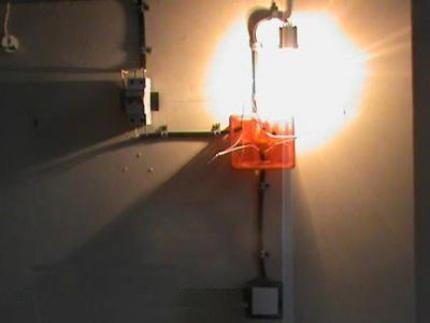
As you can see, you can complete the entire connection diagram yourself using a minimum of simple tools.
Conclusions and useful video on the topic
Useful video instructions will help novice electricians master the theory and apply it correctly in practice.
Instructions from the legrand manufacturer, which will talk about how to install the switch yourself:
From the following video you can learn about connecting a single-key switch and socket:
You will learn how to replace a switch with your own hands from the following video:
As you may have noticed, the principles of connecting various electrical devices are similar, but have slight differences. If you decide to replace the switch yourself or install the entire electrical circuit, carefully study the diagrams, consult qualified specialists, and be sure to follow safety precautions during the work.
If you have any questions about replacing single-key switches or have additions to the material, please leave your comment in the block below.




I had to replace old switches with new ones. There is nothing difficult about this. But when I had to change the wiring, I really became convinced that the wires were different colors. This is done correctly; thanks to the coloring of the insulation, it is impossible to mix up the wires when connecting. It turns out that each wire color corresponds to its purpose. If you do not pay attention to this “hint” from cable manufacturers, you will have to redo the wiring.
When purchasing switches, it is better not to save money. With an inexpensive and low-quality device, in a maximum of a month you risk finding yourself with a switch with a broken key or collapsed internals. Poor contact of the electrical wire inside the switch can, in turn, cause sparking and fire.Always buy high-quality, proven products. It is convenient when there is an LED backlight on the switch, this will help you easily determine its location in the dark.
I bought a Schneider Sedna switch, it doesn’t work as it should, as long as you hold the key, it’s on, you release the key, it returns to its original position and the light doesn’t come on, what’s the matter??